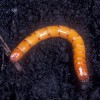 Insects in the family Elateridae are commonly known as click beetles. Their name comes from the clicking sound they make while attempting to right themselves after falling or being placed on their backs. The larvae of click beetles are called wireworms. The corn wireworm is a serious agricultural pest and was added to the EPPO A1 action list of quarantine pests in 2002. This 6-page fact sheet was written by Harsimran K. Gill, Gurminder Chahil, Gaurav Goyal, Jennifer L. Gillett-Kaufman and Ronald Cherry, and published by the UF Department of Entomology and Nematology, January 2014.
Insects in the family Elateridae are commonly known as click beetles. Their name comes from the clicking sound they make while attempting to right themselves after falling or being placed on their backs. The larvae of click beetles are called wireworms. The corn wireworm is a serious agricultural pest and was added to the EPPO A1 action list of quarantine pests in 2002. This 6-page fact sheet was written by Harsimran K. Gill, Gurminder Chahil, Gaurav Goyal, Jennifer L. Gillett-Kaufman and Ronald Cherry, and published by the UF Department of Entomology and Nematology, January 2014.
http://edis.ifas.ufl.edu/in1025
Tag: Family Elateridae
A Wireworm Conoderus rudis (Brown) (EENY507/IN909)
 Wireworms are the larvae of click beetles. These larvae are smooth, slender and round in cross-section. Wireworms are important pests of various crops and occur in all seasons at variable densities. Feeding damage is restricted to the seeds, seedlings and underground parts of the plants. Unlike foliage feeders, they are very difficult to detect due to their soil-dwelling habitat. This 4-page fact sheet was written by Dakshina R. Seal, and published by the UF Department of Entomology and Nematology, December 2011.
Wireworms are the larvae of click beetles. These larvae are smooth, slender and round in cross-section. Wireworms are important pests of various crops and occur in all seasons at variable densities. Feeding damage is restricted to the seeds, seedlings and underground parts of the plants. Unlike foliage feeders, they are very difficult to detect due to their soil-dwelling habitat. This 4-page fact sheet was written by Dakshina R. Seal, and published by the UF Department of Entomology and Nematology, December 2011.
http://edis.ifas.ufl.edu/in909
A Wireworm Conoderus scissus Schaeffer (EENY509/IN911)
 Conoderus scissus is the most abundant wireworm species found in sweet potato fields. Its preference for other crops is followed by peanut, cowpea, and corn. Learn more in this 4-page fact sheet written by Dakshina R. Seal, and published by the UF Department of Entomology and Nematology, December 2011.
Conoderus scissus is the most abundant wireworm species found in sweet potato fields. Its preference for other crops is followed by peanut, cowpea, and corn. Learn more in this 4-page fact sheet written by Dakshina R. Seal, and published by the UF Department of Entomology and Nematology, December 2011.
http://edis.ifas.ufl.edu/in911